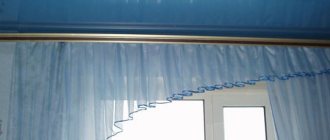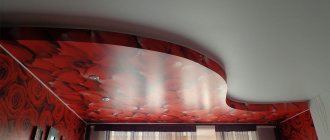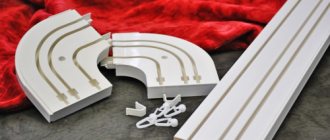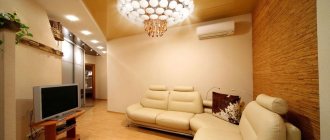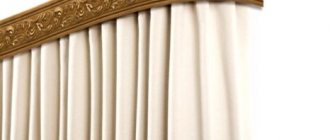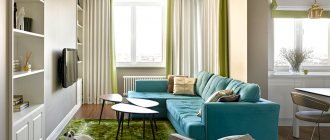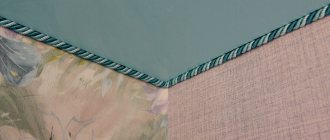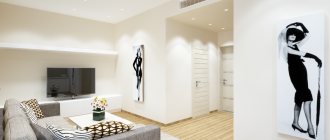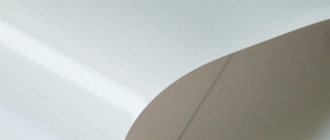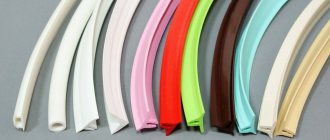Criterias of choice
There are three basic options for fastening the system that holds curtains or window curtains.
All of them are universal and quite suitable for stretch ceilings. But here it is important to remember that this method of interior improvement has its own characteristics, since tension fabric, especially PVC, is completely unsuitable as a supporting structure, does not tolerate cuts and lateral loads, and also slightly reduces the ceiling line.
So, the main classification of cornices is based on the method of their fastening.
Traditional wall option
It is extremely easy to install and requires minimal preparatory measures. It looks very good in interiors with high ceilings, but it looks extremely unprofitable where the ceiling line is lowered.
It is also important to consider the size of the window sill—more precisely, its outlet. Otherwise, it will turn out that even at the maximum reach of the mounting console, the falling curtains will begin to bulge where it protrudes into the room. This looks especially bad with curtains that reach the floor.
Ceiling mounted
A little more finicky to install. Its advantage lies in the fact that you can choose to remove the suspension from the wall at your own discretion - there are no technical restrictions, as such.
In this case, it is important to pay a little more attention to the unit responsible for direct fastening to the ceiling, since the load vector coincides with the axis of the hardware that holds the cornice itself. Therefore, everything must be done carefully: no dowels or nails, only plastic dowels and screws.
And even better are anchor structures (especially with heavy curtains) - they hold up best in such conditions.
Curtains on such a curtain visually increase the height of the room. Therefore, this type of cornice fastening should be given preference in small-sized apartments with low ceilings - it will create the illusion of additional space.
Recessed or hidden
In fact, it is a type of ceiling fastener. But, unlike its open counterpart, there is always a special niche under the cornice, hiding all the elements of curtain hanging from the observer.
It goes well with any interior style, but requires some technological tweaks.
Also, in addition to the method of fastening the cornice, it is important to pay attention to the main material from which the structure is made. There are several standard options:
tree. Most often found in wall structures or as a decorative element in baguette systems. Quite an expensive cornice, but the texture of natural wood gives a special nobility to the appearance of the curtain hanging system;
plastic. The most budget-friendly type of cornice. It is very attractive with a variety of colors: it can be white, multi-colored, or imitating natural materials. The flexibility of the material makes it possible to construct systems that are very complex in configuration and design. Thus, you can find a plastic cornice either in the French style or in the hi-tech style;
- aluminum. Lightweight, durable, quite durable cornice. A large selection of textured and color polymer coatings allows you to choose a model that matches any interior;
- steel. It is superior in strength to all previous options, so a cornice made from it is recommended for heavy and thick curtains, for complex compositions with lambrequins and other weighting components. In terms of price, it is probably the most expensive option. But such extravagance often pays off in reliability and durability.
When choosing the type of cornice, it is better to adhere to the following rule: you should first assess the load on the entire system and only after that evaluate the external data of a particular model, choosing the one that best suits the interior.
Key Features and Benefits
Ceiling rails on the market are a necessary accessory that performs two functions in the interior:
- decorative;
- functional.
Of course, no one has canceled wall-mounted options: and people often use them because they are cheap, practical and convenient. However, if you want to give your interior an individual character and move away from established design patterns, then it makes sense to take a sober look at the use of a ceiling cornice:
- saves space;
- disguises curtain fasteners;
- creates additional visual effects;
- takes part in shaping the atmosphere of the room;
- able to withstand even the heaviest curtains;
- allows you to visually increase the height of ceilings and the space as a whole to solve specific decorative problems.
Some (if not many) people believe that there is absolutely no difference between a ceiling cornice and a regular one. Meanwhile, this is fundamentally not true. For suspended ceilings, you should choose only bus profile models
- as a rule, they are produced without a baguette. Here's what they look like close up.
Materials
To understand which cornice is best to use for a suspended ceiling, you should understand the properties of all the materials from which it is made. For the production of most models, plastic is used, since it is characterized by minimal weight, a wide range of colors and resistance to negative influences such as corrosion or rotting.
However, natural raw materials continue to be in demand, so modern models can be created from the following materials:
- Steel.
- Aluminum.
- Polystyrene.
- Polyurethane.
- Wood.
Plastic
Plastic products are very popular due to their low cost and good strength properties. If necessary, the structure can be further strengthened. Plastic is also not subject to corrosion or rotting.
Aluminum
Complex openwork shapes and decorative elements are made on the basis of aluminum. The advantages of this material include:
- Ease of processing.
- Affordable price.
- Invulnerability to moisture.
- Wide range of models.
- Possibility of implementing any geometric shapes and non-standard options.
Often, bay windows are finished with aluminum structures and complex curtains are installed.
Steel
When wondering what types of cornices there are, you should also pay attention to steel structures. In most cases, they have the shape of rods, but square products are also available for sale. Depending on the interior features, steel can be finished with colored materials, including:
- Gold.
- Bronze.
- Brass.
- Copper.
The aesthetic appeal of structures is also enhanced by chrome plating. The main advantage of steel cornices is their high strength. However, they are heavy, so for error-free installation it is necessary to provide a stable mounting base.
Tree
Wood products are considered “classics of the genre”, which never loses popularity. To decorate wooden models, they are tinted, varnished or painted, and also processed using wood carving.
The disadvantages of wood include high cost and vulnerability to influences such as moisture or fire.
A wooden cornice is also quite heavy, and its installation process requires professional help. In order for a product to serve for a long time without deformation or damage, it needs to be provided with optimal climatic conditions.
Dimensions
A fairly wide range of sizes allows you to choose options for ceilings of any size, while the ceiling itself will remain without a joint.
The most popular plastic and aluminum models have similar dimensional characteristics. The length of a single profile reaches 4 m; longer or curly options are made from several elements. The width reaches 87 mm relative to the number of rows of fastenings.
The strip covering the curtain fastenings is 50 or 90 mm, while the one extended for blend patterns reaches 300 mm (quite rare custom-made models).
Wooden models are made to order, or can be purchased ready-made. The length of finished cornices is 200 cm, custom-made – up to 400 cm. There are no standard sizes for baguettes.
Cornice designs
When installing a suspended ceiling with a ceiling cornice, it is necessary to consider its design.
Single-tier and multi-tier
Single-tier models provide for the installation of canvases on the same level. Using multi-tiered models, you can quickly raise the tulle or lower the lambrequins, creating the effect of a textile waterfall.
Tire cornice
These are profile products that are combined with flexible or baguette structures. They can be shaped like a flat plate with tracks for hooks.
Strings
String curtain rods are suitable for flowing fabrics and are made in the form of stretched wire with hooks. Using the tension regulator, you can independently change the position of the tulle and maintain working condition.
This type of design fits effectively into the interior style of high-tech, urban, etc.
Profile
Profile cornices are created on the basis of plastic or metal-plastic. They have a complex profile shape with grooves for hooks. The number of rows varies from 1 to 4. Using corner elements, you can recreate the chaotic trajectory of the fabric.
Mechanical
To control the curtains, cords and chains are used. To change the position of the surface and adjust the light flux, you need to pull 1 end of the lace.
Automatic
Unlike the previous type, automatic models are equipped with motors and sensors that make them self-controlled. A special controller is used to configure automation. The home owner independently chooses the time when the curtains will open and close, depriving himself of the need to do it manually.
In addition to changing the lighting parameters, this type of curtain rods creates a feeling of the presence of the owners inside the room when they are on vacation.
Fashion trends
One of the most effective design solutions is to hide LED auxiliary lighting behind the curtains; the space is read in a new way, comes to life and is noticeably transformed. The light is reflected in the stretch ceiling, this adds color to the room and helps create an atmosphere.
Modern manufacturers offer a ready-made solution - cornices for suspended ceilings for hidden lighting. As a rule, this is a polymer profile that is fixed to the wall; special glue is used for installation.
Lighting on curtains can transform a space, making it more intimate and cozy
Which cornice to choose for a stretch ceiling
To understand which cornice to choose for a stretch ceiling, it is important to take into account a lot of nuances and criteria. The use of advanced technologies in the production of curtain rods allows us to implement the most complex and interesting ideas, so a wide selection of offers is available for sale to suit every taste. To find the right option for your home, you must follow these recommendations:
- The distance between the window opening and the ceiling structure is a decisive selection criterion. Any canvas takes up several cm of free space, so before purchasing a cornice you need to measure the wall above the window. If there is no optimal distance, it is better to choose a profile cornice.
- If the window openings in the house are large enough and the ceiling is high, the choice options expand. However, a suspended ceiling with a hidden cornice is the best solution for any interior style.
- If the ceiling is already fixed, the only option will be a wall cornice.
- If price is a key criterion, it is recommended to choose concealed models with mechanical controls. External cornice is also relatively inexpensive, but its installation process requires financial investment.
- At the stage of searching for a ceiling, you should also take into account the style of the room. Thus, a luxurious wooden baguette will fit perfectly into a Baroque or classical style interior, but will be inappropriate in minimalism. For a modern interior such as high-tech, modern, etc. choose hidden cornices.
Stylish flowing curtains are also popular, demonstrating the construction’s compliance with advanced fashion trends.
It is important to pay attention to the size and proportions of the room. Models with rounded edges are indispensable in rooms with complex layouts or limited space. You can also use round edges to disguise unpleasant defects after side trimming and correctly combine the cornice with the baseboard.
When choosing a cornice according to the installation method, you should take into account its relevance and effectiveness. In some interiors, hidden products are more in demand, while in others - open ones. Here you need to take into account the height of the ceilings. If it does not exceed 2.5 m, hidden solutions are not recommended.
An important criterion is the texture of the ceiling fabric. Since glossy surfaces are reflective, the presence of a niche cornice will provide a feeling of pouring light. The harmonious distribution of lines gives the design a special elegance and attractiveness.
If you are going to place a dividing curtain in a room, it is better to use a hidden niche.
Attaching an open cornice is inappropriate here, since attention will be focused on it. To implement such a design, it is better to seek help from specialists.
Matte ceilings are appropriate in minimalist interiors and are suitable for rooms with good lighting conditions. Some designers allow the combination of 2 types, if this does not worsen the interior design.
The key selection criterion remains the safety of the ceiling. In this regard, experts advise starting the selection before installation work begins in order to prevent numerous problems and unjustified costs.
Interesting options in the interior
If you still haven’t made your choice, then our small selection of photos of ceiling cornices for suspended ceiling structures in a variety of interiors will help you. Almost all of them confirm one correct idea: such elements have a pronounced stylistic versatility, because they easily fit into both the classic format and fashionable high-tech interiors.
Of course, flowing curtains have a special interior magic. You already know how to achieve such a bright and wonderful effect. As you can see, it is appropriate in both high-tech and quite ordinary home interiors.
But when choosing ceiling rails in a distinctly French style, you should be careful - they require mandatory elaboration in a similar vein for other elements of the room’s design. The same applies to wooden structures, which reveal their full decorative potential precisely in the format of a spacious living room in a private house. Or the bedroom, it’s entirely up to your taste.
How to install?
The installation of built-in and open cornices is quite different. If you are not confident enough in your abilities, do not have suitable experience in the construction business, and if you have the opportunity to hire professionals, we strongly recommend that you contact the company. Installing a cornice is not a quick and rather painstaking task. However, it is possible to do everything yourself if you follow the instructions.
It should be repeated again that the decision to install any type of ceiling cornice is made at the planning stage of installing a stretch ceiling.
To hang an open structure, you must complete the following steps:
- Mark the future position of the cornice on the ceiling.
- Attach the fixing frame to the walls.
- Secure a wooden beam the length of the cornice, and such a thickness that it fits against the future ceiling sheet. Please note that the beam must be well processed to remove all irregularities and roughness. It is also necessary to treat it with an antiseptic solution to prevent the growth of fungi and mold.
- Stretch the ceiling. First you need to glue protective rings onto it with holes burned inside for twisting. It’s better to just burn the holes, so you’ll melt the edges.
- Screw the cornice using self-tapping screws to the beam.
Make sure that the screws fit exactly into the holes in the ceiling panel. Without securing a sufficiently fragile canvas, you risk tearing it and sending the “arrow” further across the entire surface.
To attach a niche cornice, do the following:
- Screw the cornice to the main ceiling where you have planned its location.
- Attach the beam with clamps almost close to the cornice. It should help hide the cornice, so choose the right height.
- Attach the canvas fastener to the beam and, based on the height of the fastening, tension the ceiling.
- All precautions for the beam and for the canvas are the same as for fastening an open structure.
When installing the mount on a bay window, try to choose solid bars up to each of the kinks. This way you will avoid insufficiently secure fastening of screws in the beams.
It is recommended to choose good quality solid wood beams for beams. If the quality of the board is poor, there is a possibility that it will crumble as a result and that the screws will not hold securely enough.
Be extremely careful when installing hidden curtain rods. Its edges must first be wrapped with masking tape so that when stretching the ceiling fabric they do not damage the material with sharp corners.
It is generally recommended to sharpen the edges a little so that they do not cause problems or complaints in the future.
Types of sliding curtains
Light, almost transparent, elegant curtains. Their goal is to hide the home from views from the street, if it is the first floor, and to dim the bright sunlight. Along the lower edge, the fabric is often decorated with scallops, applique or sewing.
Curtain drapery – thick, almost impenetrable “night” curtains. Protects from heat in summer and from excessive evening and night outdoor lighting. Curtains are often decorated with a variety of decor.
Kiseya. Used as additional window decoration, and as a separate curtain.
An original part of the decoration will be a cornice illuminated with an attractive neon light.
How to remove?
Removing a ceiling cornice is much easier than hanging it. All that is required is to unscrew the screws and remove the cornice.
If you dismantle the structure yourself, it is recommended to start unscrewing it from the sides, gradually moving towards the middle. This way you will avoid damage to the cornice itself.
When removing, you need to be extremely careful and make sure that the sharp edges of the profile do not scratch the ceiling. The least this can entail is unsightly tightening, but you can also make a hole in the ceiling, and replacing the fabric will be quite expensive.
Remember that you can only hang another cornice in the same place where the previous one hung, and you will have to fall into the same holes in the ceiling sheet. If you plan to change the cornices in the future, it is recommended to install dowels for repeated use instead of self-tapping screws.
Curtain fabrics
The texture of the curtain fabric determines their placement. To ensure good daylight, thin translucent curtains are hung.
In order to muffle very bright sunlight in bedrooms, children's rooms, and offices, thick cotton, velvet or velor curtains are hung.
Natural fabrics are suitable for classic-style rooms, while easy-to-care synthetic fabrics are suitable for modern design.
There are even more ideas for decorating curtains in a modern interior on the website https://shtora.guru.
We must remember that curtains made from natural fabrics cannot be combined with synthetic curtains.
Features of installation of various cornices
Of course, the basic procedure for installing any curtain rod is approximately the same. Anyone who knows how to fasten a dish rack will quickly understand how to fasten any cornice. There are simply subtleties, knowledge of which simplifies the technical side of this event.
On the wall
There are no special difficulties in how to hang a cornice on the wall. But it’s better to start this after the suspended ceiling is in its normal place. This slowness allows you to more accurately determine the height of the ceiling - until then it is unclear how much it will lower as a result of tensioning the canvas.
And the marking process itself with a ready-made horizontal surface, from which you can accurately set the same distance along the entire perimeter of the room, is much simpler. Even in cases where the consoles for fastening the cornice are made as separate elements, it is quite easy to make a mistake by not maintaining the level.
To the ceiling
If you have a suspended ceiling, this method of installing a cornice only at first glance seems complicated and troublesome. In fact, even inexperienced installers can very quickly figure out how to do everything simply and without compromising quality and reliability.
The cornice is not held on the tension fabric. The entire load is perceived by a wooden beam, passed along the room directly behind the canvas and therefore completely hidden from the observer.
Sometimes the timber is replaced with separate platforms made of small boards. But this is a less reliable option - it’s more difficult to adjust, and it’s much more difficult to guess with the mounting points where these elements should be. It is much easier to use solid timber. And it’s better if it goes from edge to edge, from wall to wall.
This wooden element can be hung using adjustable hangers from the arsenal of drywallers or pulled to a pre-fixed corner - all options have a right to exist.
The main thing is that there is a possibility of slight maneuver when adjusting the mounting height of this beam.
Naturally, you should choose a tree that is absolutely dry - this will save it from warping when humidity fluctuates. And be sure to protect it with an antiseptic before installation. This way you can protect the node from the appearance of fungus.
This beam is placed immediately after the anchor system holding the canvas is marked and secured around the perimeter of the room.
The beam under the cornice should be clearly at the height of the ceiling (more precisely, just a little higher than the canvas). Otherwise, it will either become noticeable under the canvas after tensioning, or when attaching the cornice, there will be a risk of the formation of unevenness, a depression - the ideal ceiling plane after tension will be distorted as soon as the cornice is attracted to the embedded board.
Hidden installation
The essence of the method is that a niche is made between the ceiling and the wall with the window, into which the entire cornice system is placed. Since the ceiling does not fit close to this wall, the anchor is not attached to it, but to a special corner profile that is level with the fastening on other walls.
The ceiling that is not brought to the wall and the wall itself form a groove that hides the system on which the curtains are attached. It is interesting that this hidden structure, after the curtains are hung, is almost indistinguishable to the observer, even if he is directly under it - the folds of the fabric get in the way. It seems that the curtains were done without a cornice at all.
Theoretically, such a hidden cornice can be installed before installing the suspended ceiling. Although in reality it is better to do this after tensioning, otherwise the cornice will slightly interfere with securing the edge of the ceiling sheet in the anchor.
In addition to some general design moves, such a niche makes it possible to play a little with lighting - an LED strip is placed along its edge from the inside, and the color of the illumination can be contrasting with the main lighting.
And then an effect appears, somewhat similar to the so-called “floating ceilings” - when the surface looks weightless, as if suspended in the air.
